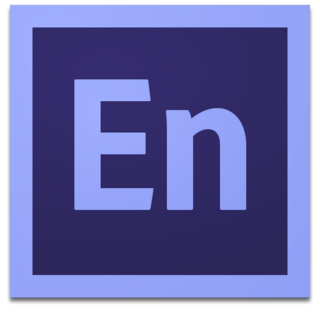
Adobe Photoshop is a raster graphics editor developed and published by Adobe for Windows and macOS. It was originally created in 1987 by Thomas and John Knoll. Since then, the software has become the most used tool for professional digital art, especially in raster graphics editing. Owing to its fame, the program's name has become genericised as a verb although Adobe disapproves of such use.
Windows Media Audio (WMA) is a series of audio codecs and their corresponding audio coding formats developed by Microsoft. It is a proprietary technology that forms part of the Windows Media framework. WMA consists of four distinct codecs. The original WMA codec, known simply as WMA, was conceived as a competitor to the popular MP3 and RealAudio codecs. WMA Pro, a newer and more advanced codec, supports multichannel and high resolution audio. A lossless codec, WMA Lossless, compresses audio data without loss of audio fidelity. WMA Voice, targeted at voice content, applies compression using a range of low bit rates. Microsoft has also developed a digital container format called Advanced Systems Format to store audio encoded by WMA.

Adobe Illustrator is a vector graphics editor and design program developed and marketed by Adobe. Originally designed for the Apple Macintosh, development of Adobe Illustrator began in 1985. Along with Creative Cloud, Illustrator CC was released. The latest version, Illustrator 2024, was released on October 10, 2023, and is the 28th generation in the product line. Adobe Illustrator was reviewed as the best vector graphics editing program in 2021 by hpMagazine.

Adobe InDesign is a desktop publishing and page layout designing software application produced by Adobe and first released in 1999. It can be used to create works such as posters, flyers, brochures, magazines, newspapers, presentations, books and ebooks. InDesign can also publish content suitable for tablet devices in conjunction with Adobe Digital Publishing Suite. Graphic designers and production artists are the principal users.

Adobe Dreamweaver is a proprietary web development tool from Adobe. It was created by Macromedia in 1997 and developed by them until Macromedia was acquired by Adobe Systems in 2005.

Adobe Creative Suite (CS) is a discontinued software suite of graphic design, video editing, and web development applications developed by Adobe Systems.

Adobe Premiere Pro is a timeline-based and non-linear video editing software application (NLE) developed by Adobe and published as part of the Adobe Creative Cloud licensing program. First launched in 2003, Adobe Premiere Pro is a successor of Adobe Premiere. It is geared towards professional video editing, while its sibling, Adobe Premiere Elements, targets the consumer market.

Vegas Pro is a professional video editing software package for non-linear editing (NLE). The first release of Vegas Beta was on 11 June 1999. The software runs on the Windows operating system.
Final Cut Express was a video editing software suite created by Apple Inc. It was the consumer version of Final Cut Pro and was designed for advanced editing of digital video as well as high-definition video, which was used by many amateur and professional videographers. Final Cut Express was considered a step above iMovie in terms of capabilities, but a step underneath Final Cut Pro and its suite of applications. As of June 21, 2011, Final Cut Express was discontinued in favor of Final Cut Pro X.

Adobe Encore was a DVD authoring software tool produced by Adobe Systems and targeted at professional video producers. Video and audio resources could be used in their current format for development, allowing the user to transcode them to MPEG-2 video and Dolby Digital audio upon project completion. DVD menus could be created and edited in Adobe Photoshop using special layering techniques. Adobe Encore did not support writing to a Blu-ray Disc using AVCHD 2.0.

Sound Forge is a digital audio editing suite by Magix Software GmbH, which is aimed at the professional and semi-professional markets. There are two versions of Sound Forge: Sound Forge Pro 12 released in April 2018 and Sound Forge Audio Studio 13 released in January 2019. Both are well known digital audio editors and offer recording, audio editing, audio mastering and processing.

Adobe InCopy is a professional word processor made by Adobe Inc. that integrates with Adobe InDesign. InCopy is used for general word processing, in contrast to InDesign, which is used to publish printed material, including newspapers and magazines. The software enables editors to write, edit, and design documents. The software includes standard word processing features such as spell check, track changes, and word count, and has various viewing modes that allow editors to visually inspect design elements — just as it looks to the designer working in Adobe InDesign.

Adobe Bridge is a free digital asset management app made by Adobe Inc. and first released with Adobe Creative Suite 2. It is a mandatory component of Adobe Creative Suite, Adobe eLearning Suite, Adobe Technical Communication Suite and Adobe Photoshop CS2 through CS6. Starting with Creative Cloud, however, it has become an optional component downloaded via Creative Cloud subscription.

K-Multimedia Player is an Adware-supported media player for Windows and iOS that can play most current audio and video formats, including VCD, HDML, DVD, AVI, MKV, Ogg, OGM, 3GP, MPEG-1/2/4, AAC, WMA 7, 8, WMV, RealMedia, FLV and QuickTime. KMPlayer shows many advertisements, including in the homepage, side panels, options panel, and as pop-up ads.

Soundbooth was a digital audio editor by Adobe Systems Incorporated for Windows XP, Windows Vista, 7 and Mac OS X. Adobe has described it as being "in the spirit of SoundEdit 16 and Cool Edit 2000". Adobe also has a more powerful program called Adobe Audition, which replaced Soundbooth as of Adobe Creative Suite 5.5 Production Premium. Soundbooth, discontinued in 2011, was aimed at creative professionals who do not specialize in audio or people who need a simple editing program and do not require the full features of Adobe Audition. Due to Intel-specific code, Adobe stated that the Mac OS X version would only be available for machines using Intel processors. Soundbooth CS4 was the first version to support 64-bit officially.
Adobe Technical Communication Suite is a collection of applications made by Adobe for technical communicators, help authors, instructional designers, and eLearning and training design professionals. It includes Adobe FrameMaker, Adobe RoboHelp, Adobe Acrobat, Adobe Captivate, and Adobe Presenter.

Adobe eLearning Suite was a collection of applications made by Adobe Systems for learning professionals, instructional designers, training managers, content developers, and educators.

MAGIX Samplitude/ Sequoia is a computer program made by MAGIX for recording, editing, mixing, mastering and outputting audio. The first version was released in 1992 for the Amiga and three years later for Microsoft Windows. The latest versions of the software are Samplitude Pro X5, Samplitude Pro X5 Suite and Sequoia 16. Samplitude is an example of a digital audio workstation (DAW).

Adobe Prelude is a discontinued ingest and logging software application for tagging media with metadata for searching, post-production workflows, and footage lifecycle management. Adobe Prelude is also made to work closely with Adobe Premiere Pro. It is part of the Adobe Creative Cloud and is geared towards professional video editing alone or with a group. The software also offers features like rough cut creation. A speech transcription feature was removed in December 2014.
Boris RED is an integrated 3D compositing, titling, and effects application that works with the Adobe Creative Suite, Avid, Apple, Grass Valley, Media 100 and Sony editing systems. RED adds features to NLE timelines and integrates a standalone engine for effects creation and rendering.




